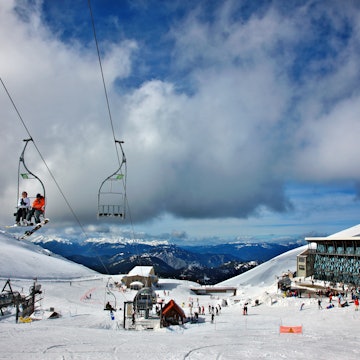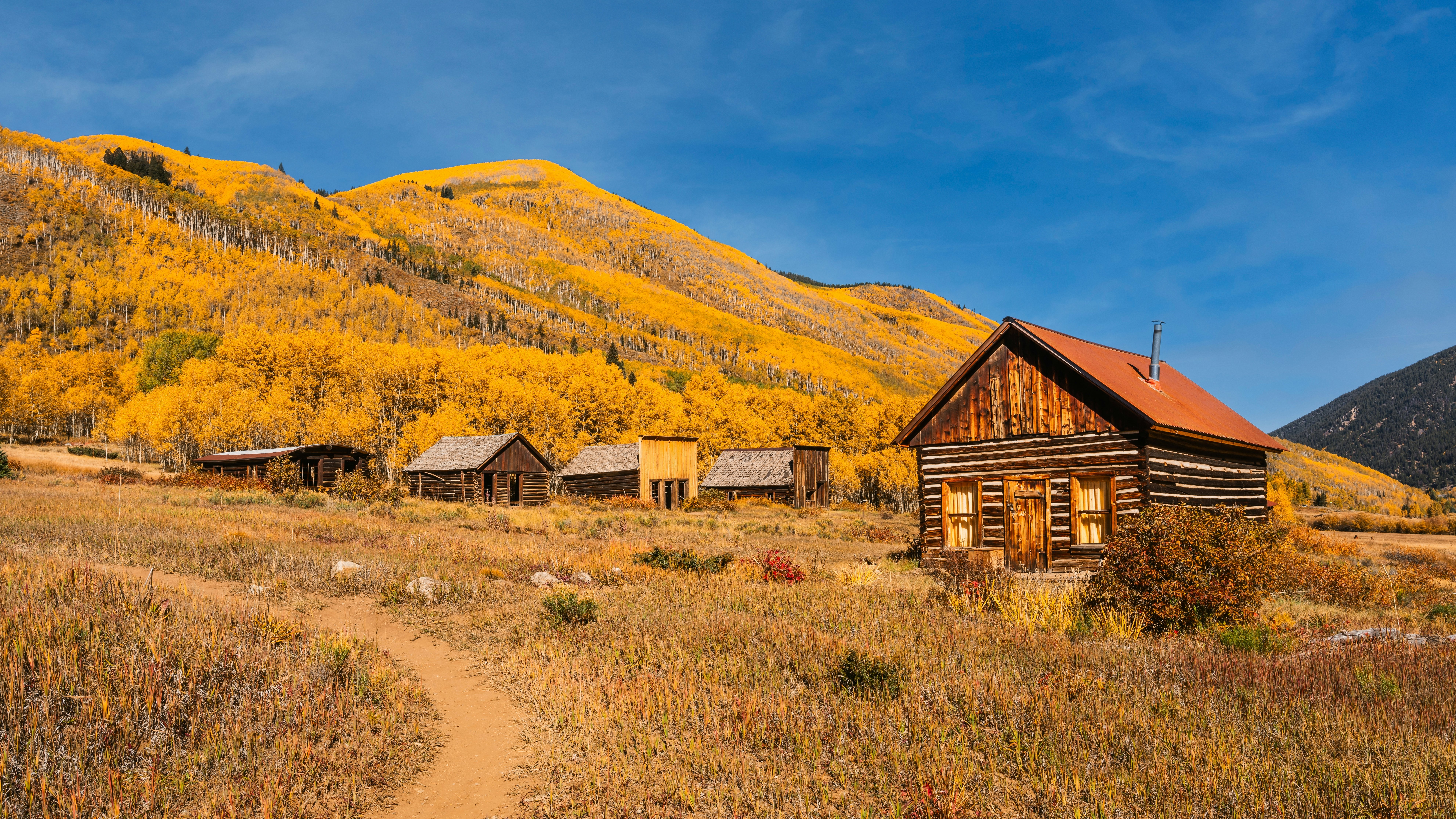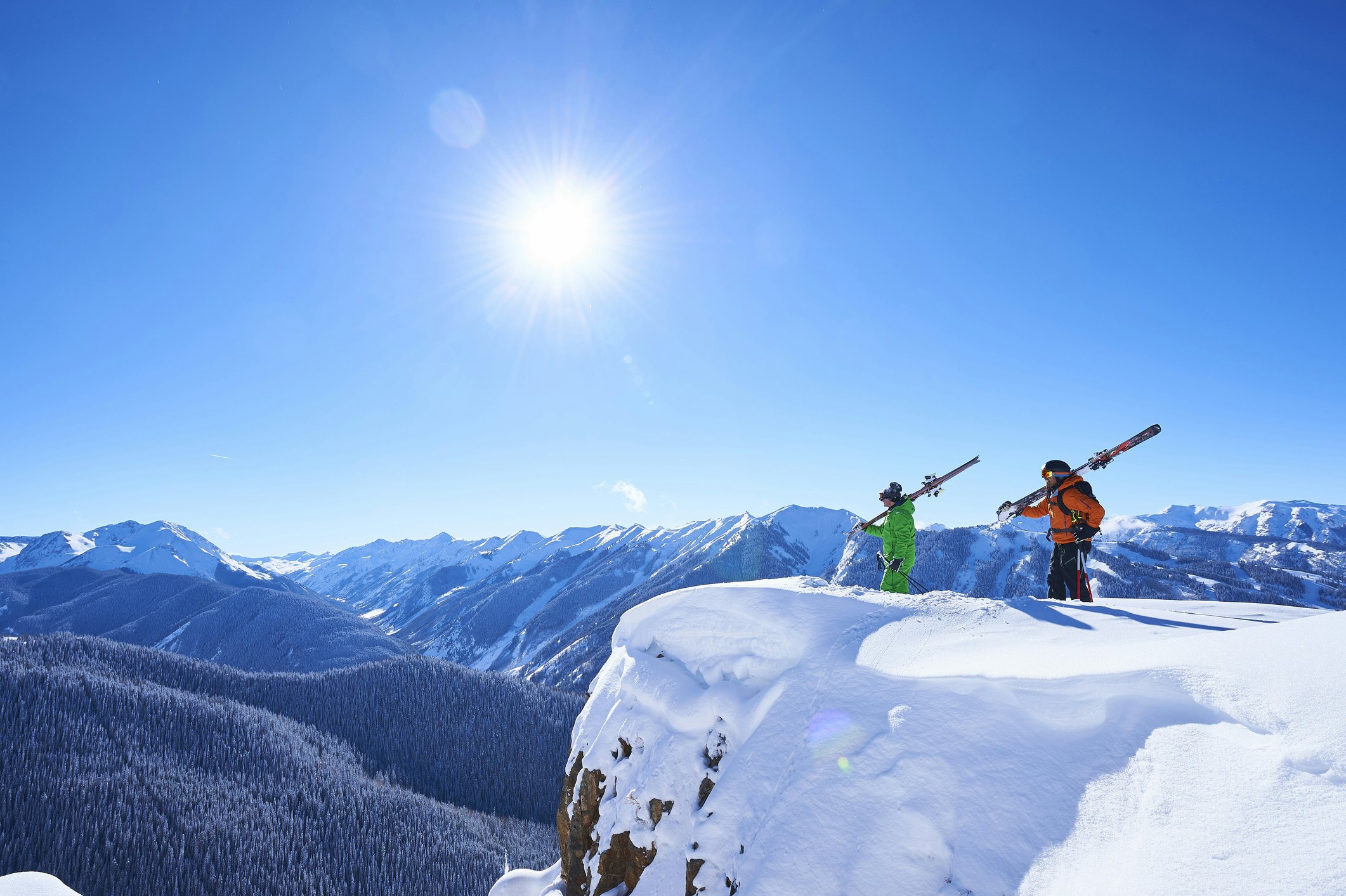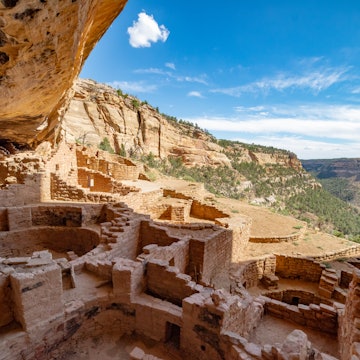

A moose walking through Maroon Lake near Aspen, Colorado. Sean Xu/Shutterstock
Aspen is best known as a luxury travel destination for the rich and famous – celebrities, politicians, business tycoons and other A-listers vacation here year-round.
But if you think this mountain town is all about steep ski prices and posh pursuits, you’d be wrong. It packs a punch with budget-conscious activities too, from outdoor pursuits and history to art finds.
While often compared to Vail, which is known for its centralized village and European-inspired architecture, Aspen stands apart with its small-town charm and vibrant arts and culture scene. If you’re planning an affordable trip to Aspen, bookmark this list of free things to do and discover all that the Roaring Fork Valley has to offer.
1. Pedal around town on a bike
Riding a bike is one of the best ways to experience Aspen. And, thanks to the city's WE-cycle bikeshare program, you can take short trips on traditional pedal bikes or electric bikes (e-bikes) for free.
WE-cycle offers free, unlimited rides of up to 30 minutes. The bike-share program is designed for short, point-to-point trips – pedaling from a restaurant on one end of town to a museum on the other, for example – but you can ride as many times as you want. (If you’re looking for a longer-term rental or a specific type of bike, there are several bike rental shops in town, too.) Many hotels also offer complimentary bikes to their guests.
Planning tip: Be sure to familiarize yourself with the 50 WE-cycle station locations in advance, as docking your bike within 30 minutes will keep your ride free. After 30 minutes, the rate goes up to 0.50 US dollars (US$) per minute for pedal bikes and US$5 per minute for e-bikes.

2. Hum a tune in the John Denver Sanctuary
John Denver was one of Aspen’s best-known residents. Though the singer-songwriter famous for “Rocky Mountain High” and other folk hits died in 1997, his memory lives on through the John Denver Sanctuary, located along the banks of the Roaring Fork River in the center of Aspen.
The serene spot, situated within Rio Grande Park, features colorful perennials, grassy knolls, gurgling streams, small waterfalls and native trees and shrubs – even if you’re not a fan of Denver or his music, it’s an idyllic place to have a picnic or spend a contemplative moment watching the hummingbirds flit from flower to flower. The site’s Song Garden is home to several massive boulders with etchings of Denver’s song lyrics.
The sanctuary, which doubles as Aspen’s stormwater filtration system, is free and open to the public. And if you’re looking for other ways to celebrate Denver’s life, consider attending the John Denver Celebration, an annual, multi-day event held each October – many of the gatherings and activities are also free.

3. Travel back in time at Independence Ghost Town
Fortune hunters struck it big when they discovered gold just below the Continental Divide on July 4, 1879. They set up their tents and created a small community called Independence at 10,830ft above sea level. This high-altitude mining town boomed, growing to some 1500 residents, three post offices and more than 40 businesses by 1882 (it even had its own newspaper, The Independence Miner).
But, as gold production dwindled, so too did the town’s population – many miners packed up and moved to nearby Aspen, which had a milder climate and plenty of jobs. A few dogged residents remained, but eventually, Independence became a deserted ghost town. Today, Independence Ghost Town has been preserved and reconstructed by the Aspen Historical Society and is free to wander through, though there’s a suggested donation of US$5 per person. There are walking paths, interpretive signs, artifacts, restored log cabins and the ruins of other buildings from the 1880s.
Detour: After exploring Independence Ghost Town, continue on to Ashcroft Ghost Town, another former mining town just 10 miles south of Aspen. This location has a US$5 admission fee.

4. Try cross-country skiing or snowshoeing
If you’ve got your own gear, it’s free to cross-country ski or snowshoe on the Aspen Snowmass Nordic Ski Trail System, which is one of the largest free systems of its kind in the country. There are more than 55 miles of free trails to explore. There are also a handful of trails designated for fat bikes, or bikes with especially wide tires designed for riding over snow.
If you’ve never skied before, or you just want to brush up on the basics, there are group and private lessons (for a fee: around US$20-50), plus guided cross-country ski tours. You can rent gear or get your equipment tuned at the Aspen Cross Country Center.
Planning tip: Bring your dog along for the adventure. Several trails in the system are dog-friendly.
5. Get inspired at the Aspen Art Museum
Aspen has a world-class art museum – and it’s always free. The three-story space, located right downtown, has a striking appearance, with a facade on two sides that looks like a woven basket. Inside, the museum is modern and full of natural light, with galleries on the first and second floors. The museum’s third level is a hybrid indoor-outdoor space, complete with a rooftop garden that also features art and a popular lunch cafe.
In addition to rotating exhibitions (the museum is a non-collecting institution, so it has no permanent collection), the Aspen Art Museum hosts an array of lectures, musical performances, film screenings, workshops and programming for kids and adults.

6. Check out the goods at Aspen Saturday Market
Every Saturday from June to October, the streets of downtown Aspen come alive with farmers, ranchers, purveyors, vendors and artisans. Even if you don’t buy anything, the free Aspen Saturday Market is great for people-watching, checking out the wares of some really talented artists, chatting to Colorado growers and just enjoying the sunshine.
Planning tip: Arrive early to beat the crowds.
7. Scope out the Aspen Institute
Herbert Bayer was a student of The Bauhaus, the influential school for art and design in Germany that operated from 1919 to 1933. Bayer moved to Aspen in 1946 at the invitation of Walter and Elizabeth Paepcke, a philanthropic Chicago couple who decided to invest in the city and make it a hub for skiing, arts, culture and intellectual exploration.
To that end, the Paepckes founded the Aspen Institute, which hosted seminars, lectures, discussions, concerts and more – and, importantly, they asked Bayer to design it. Today, the campus is a shining example of Bauhaus style, which prioritized functionality and featured crisp, clean geometric shapes and bold colors. You can use their walking and art guide (free online) to explore Bayer’s artwork and architectural design principles across the 40-acre property; the on-site art galleries are also free and open to the public.
Detour: After exploring the campus, head to the nearby Aspen Meadows Resort for a relaxing stroll through the art-filled grounds. You can also stay at the 98-suite hotel.

8. Hike to the top of Aspen Mountain
Before and after ski season, you can hike up Aspen Mountain for free – no lift ticket or ski pass required. The Ute Trail, which starts just steps from downtown Aspen, climbs among the evergreen and aspen trees while offering sweeping views of the city below. Make the Sundeck restaurant your target destination, then perhaps reward yourself with a pizza and a beer (sadly, not free!).
Plan your hike to coincide with weekend classical and bluegrass performances atop Aspen Mountain in the summer (although you will need to buy a gondola or sightseeing ticket to attend).
There are dozens of other free hikes in Aspen, all ranging in difficulty level, views and terrain. Some of the best hiking trails include the Maroon Lake Scenic Trail, where you’ll be rewarded with postcard-perfect views of the Maroon Bells – two of Colorado’s most photographed peaks.
For a more peaceful hike, head to Castle Creek Road, where you can explore the Ashcroft Ghost Town or continue deeper into the White River National Forest. If you’re up for a challenge, tackle the Crater Lake Trail, which has a rugged, rocky path leading to an alpine lake surrounded by dramatic mountain peaks.
9. Get creative at Anderson Ranch Arts Center
Head over to Snowmass, Aspen’s neighboring city, to wander the grounds of Anderson Ranch Arts Center. In 1966, ceramicist Paul Soldner purchased the 5-acre property and its 14 ranch buildings with the goal of creating an artistic hub in the Rockies. Today, Anderson Ranch continues that legacy with artists-in-residence programs, 55,000-sq-ft of studio space for artists, lectures, workshops, salons and other events.
The tree-lined campus itself is gorgeous, and it’s all free and open to the public. Wander through the Patton-Malott Gallery, which hosts rotating exhibitions throughout the year, then check out the outdoor sculptures. The ranch also has a cafe and a store that sells art supplies and original art. Aspen is also home to many downtown art galleries – and window shopping is always free.

10. Walk, cycle or rollerblade the Rio Grande Trail
The Rio Grande Trail spans 42 miles between Aspen and Glenwood Springs. It’s free to use, mostly flat and paved for some stretches, which makes it the perfect place to get outside and enjoy Aspen’s fresh air. The accessible Rio Grande also serves as the backbone to the Roaring Fork Valley’s wider network of trails, helping to connect runners, walkers, cyclists and other users with dozens of other routes and trailheads, all without needing a car.
11. Take a history lesson in mining and ranching
Managed by the Aspen Historical Society, the Holden/Marolt Mining & Ranching Museum is located on the grounds of the Holden Lixiviation Works, which processed silver ore during Aspen’s mining boom. The plant operated for just one year before silver collapsed. Later, after it closed, the Marolt family purchased the property and combined it with their existing land to create the Marolt Ranch, where they raised livestock and grew potatoes.
Today, the property offers a window into Aspen’s past, sharing stories and artifacts from the city’s industrial and agricultural days. The museum and its grounds are free and open to the public (museum hours vary depending on the season).

12. Drive the scenic Independence Pass
As it’s one of the highest paved roads in North America, reaching over 12,000ft, driving through Independence Pass is a breathtaking way to see the Rockies. The winding road cuts through the mountains and offers stunning views of the Continental Divide – clearly marked with ample parking for grabbing photos to prove you stood there – as well as alpine lakes and the lush valleys below.
The scenic drive is especially popular for its fall foliage when the aspens and cottonwoods turn a vivid gold. Along the way, pull over to hike one of the many trails, such as the Lost Man Loop, a 4.3-mile hike, or take photos at designated overlooks for panoramic shots.
Planning tip: This road typically closes during the winter months (as early as late October and through as late as May) due to heavy snowfall. Even during the summer afternoon, thunderstorms or road maintenance can cause temporary closures. Check road closure updates through the Colorado Department of Transportation before setting off.
13. Take a dip in the nearby hot springs
After a day of adventuring, there’s no better way to unwind than soaking in one of the area’s natural hot springs. While Glenwood Hot Springs is the most well-known, a lesser-known, free option is Penny Hot Springs, just a short drive from Aspen. Tucked along the banks of the Crystal River, Penny Hot Springs features a more secluded experience where you can relax in geothermal waters and ease sore muscles after a strenuous hike.
Detour: Stop by the charming town of Carbondale, 20 minutes away, to explore local shops and restaurants or grab a coffee.

14. Discover classic theater at Wheeler Opera House
Aspen’s Wheeler Opera House has been a cornerstone of the city’s arts and culture scene since it opened in 1889. Built during the height of Aspen’s silver mining boom, the opera house was funded by Jerome B Wheeler, a local businessman and mining investor. Over the years, it has hosted everything from vaudeville performances to modern-day concerts, film festivals and comedy shows.
Today, the beautifully restored Victorian theater has free self-guided tours where visitors can admire its historic architecture, including intricately carved woodwork and plush velvet seating. If you’re interested in attending a show, the opera house often hosts free or low-cost performances, especially during Aspen’s annual festivals.
15. Connect with nature at Hallam Lake
Just a short walk from downtown Aspen, Hallam Lake is a peaceful nature preserve managed by the Aspen Center for Environmental Studies (ACES). The 25-acre property is perfect for birdwatching, wildlife viewing, or simply strolling along the quiet lakeshore. ACES also provides educational programs, guided tours, seasonal events and forest sound baths.
















